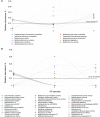Archaeal Communities: The Microbial Phylogenomic Frontier
- PMID: 35154237
- PMCID: PMC8826477
- DOI: 10.3389/fgene.2021.693193
Archaeal Communities: The Microbial Phylogenomic Frontier
Abstract
Archaea are a unique system for investigating the diversity of life. There are the most diverse group of organisms with the longest evolutionary history of life on Earth. Phylogenomic investigations reveal the complex evolutionary history of Archaea, overturning longstanding views of the history of life. They exist in the harshest environments and benign conditions, providing a system to investigate the basis for living in extreme environments. They are frequently members of microbial communities, albeit generally rare. Archaea were central in the evolution of Eukaryotes and can be used as a proxy for studying life on other planets. Future advances will depend not only upon phylogenomic studies but also on a better understanding of isolation and cultivation techniques.
Keywords: archaea; archaeal phylogenetics; eukaryogenesis; extremophiles; metagenomics; microbial-communities; phylogenomics; rare biosphere.
Copyright © 2022 Medina-Chávez and Travisano.
Conflict of interest statement
The authors declare that the research was conducted in the absence of any commercial or financial relationships that could be construed as a potential conflict of interest.
Figures


References
Publication types
LinkOut - more resources
Full Text Sources

